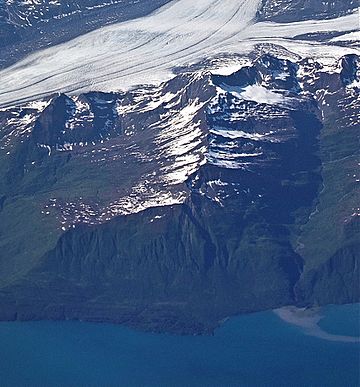Mount Hogan facts for kids
Quick facts for kids Mount Hogan |
|
|---|---|

Mt. Hogan aerial from south
|
|
| Highest point | |
| Elevation | 5,453 ft (1,662 m) |
| Prominence | 1,203 ft (367 m) |
| Isolation | 3.24 mi (5.21 km) |
| Geography | |
| Location | Valdez-Cordova Borough Alaska, United States |
| Parent range | Chugach Mountains |
| Topo map | USGS Valdez A-7 |
Mount Hogan is a mountain in Alaska, United States. It stands 5,453-foot (1,662 m) (about 1,662 meters) tall. This peak is part of the Chugach Mountains. It is located about 10.5 mi (17 km) northwest of the town of Valdez, Alaska. Even though it's not the tallest mountain, it rises sharply from the water. The southern side of Mount Hogan starts right from the tidewater of Port Valdez. Tidewater means the part of a river or bay that is affected by the ocean's tides. The mountain was named by local gold prospectors. This name was officially reported in 1911 by the United States Geological Survey.
Understanding Mount Hogan's Climate
Mount Hogan has a subarctic climate. This means it has very long, cold, and snowy winters. The summers are usually mild. The weather here is greatly affected by the Gulf of Alaska. When air from the Gulf moves towards the land, the Chugach Mountains force it upwards. This process is called orographic lift. As the air rises, it cools down and drops a lot of rain and snow.
Temperatures and Glaciers
In winter, temperatures on Mount Hogan can drop very low. They can go below −20 °C (which is −4 °F). With wind, it can feel even colder, sometimes below −30 °C (−22 °F). This cold climate helps to form and keep glaciers. There is an unnamed glacier on the east side of the mountain. Also, the huge Shoup Glacier covers the northern part of Mount Hogan.


